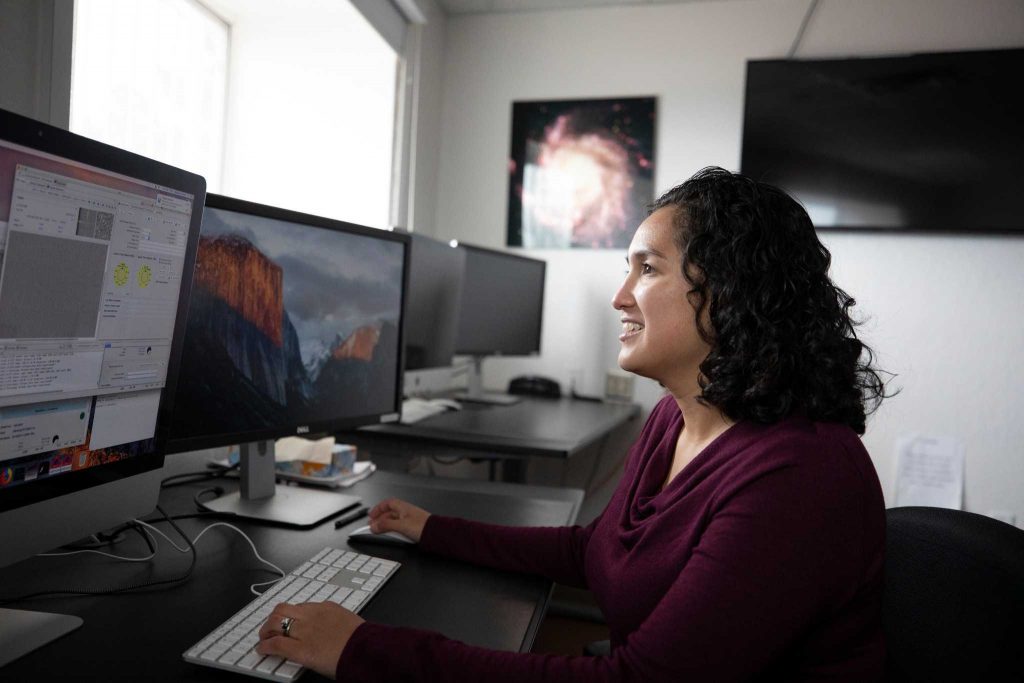Asteroid impacts are the only potentially preventable natural disaster on Earth—assuming a threatening asteroid is detected with enough lead time to launch a mission into space to deflect it.
Through its Planetary Defense Coordination Office, NASA sponsors projects to track and characterize potentially hazardous asteroids (PHAs) and other near-Earth objects (NEOs) whose orbits predict they will come within five million miles of Earth’s orbit.
One of these projects, the MIT-Hawaii Near-Earth Object Spectroscopic Survey (MITHNEOS), has been contributing critical data supporting NASA’s efforts for more than 20 years. The catalog compiled through this survey—which currently includes nearly 1,000 objects—enables NASA to predict close approaches to Earth by PHAs and NEOs and issue warnings to the government, the media and the public should there pose any potential for impact.
Assistant professor Cristina Thomas of Northern Arizona University’s Department of Astronomy and Planetary Science, who started working on the project as a Ph.D. candidate at the Massachusetts Institute of Technology , has now taken the lead as the principal investigator, funded through a $848,013 grant from NASA for the next three years.
“It’s been really exciting to see this project evolve over time and how things change,” Thomas said.
The team’s primary goal is to spectrally characterize NEOs and PHAs—both newly discovered as well as those previously known—which includes determining physical characteristics of these objects, including their composition, surface properties and size.
“Some big questions we want to answer are things like what are these objects made of, especially the ones that are most likely to hit the Earth? What would happen if an object like that was on a collision course with Earth? Or what if it did hit the Earth’s atmosphere?
“The meteor crater impact in northern Arizona, for example, was an iron meteorite, so something like that is going to create a much bigger crater compared to an object of a similar size that’s very ‘fluffy,’ kind of like loosely consolidated rocks held together by their own gravity,” Thomas said. “There’s a huge range of what could happen depending on what an object is made of, so understanding the entire population of NEOs will really come in handy for predicting their behavior and potential impact.”
MITHNEOS brings together the asteroid observing expertise of scientists at MIT, the Johns Hopkins Applied Physics Laboratory (APL), the University of Hawaii and NASA’s Infrared Telescope Facility (IRTF) on the Big Island of Hawai’i to perform spectroscopic reconnaissance of NEOs using the IRTF, which is a 3.2-meter telescope optimized for infrared observations. The MITHNEOS scientists make their spectra publicly available so that other teams can use their data set.
In addition to drawing on Thomas’ expertise, the team also will rely on NAU Ph.D. student Lauren McGraw and her advisor, professor Josh Emery, as well as co-investigators Andy Rivkin at APL and Francesca DeMeo at MIT, former PI of the project.
“I think it’s going to be really exciting,” Thomas said. “Many of the folks I get to work with have been doing this for a long time. It’s going to be a fantastic opportunity to work with some great folks and really make this a success. Our project has built a very good reputation over the last 20 years. We try to target scientifically interesting targets, and even though we do a lot of our own science with that, one of our key goals is to put the data on our website as quickly as possible so that everybody has access to it. So, if there’s a particularly interesting target to someone, they can go to our site and see the spectrum of it.”
The team has arranged one night on the IRTF observing schedule every month and hopes to obtain about 200 observations using the telescope to grow the MITHNEOS catalog of objects.
Thomas is going beyond the scope of previous projects. “We’re extending out to a different wavelength mode than the survey has done in the past, which will tell us a lot about hydration, things like water on the surface of the objects, which could be really interesting. And that’s much harder to do, so we’re going to do a relatively small number of those targets.
“We try to think about what we’re missing every time we submit a new proposal for this program, so this time we decided to try to target smaller objects. Some studies say that the small objects might have different compositions than the big objects in the near-Earth population, which we don’t understand, so we’re trying to follow that up. Once we understand the entire population, we can better understand what it tells us and how it helps us understand what we might do in the event of a potential impact event.”
Thomas’ important role in asteroid deflection
NASA and its partners are studying several different approaches to deflecting a hazardous asteroid, the most advanced of which is called a kinetic impactor. NASA launched a mission to demonstrate this technology, the Double-Asteroid Redirection Test (DART), in November. Thomas is the lead of the DART Observations Working Group on what is the world’s first full-scale planetary defense test.
She explains that both DART and MITHNEOS are run through NASA’s Planetary Defense Coordination Office. “DART is what we do if something is headed toward Earth, while MITHNEOS is focused on understanding and characterizing the population of near-Earth objects,” Thomas said. “One of the great things about surveys like this that have been supported for such a long time is that as we keep observing, we find new questions. And I think that it’s going to be really interesting to see what the next questions are. I’m also really excited to see what we can do next. We want to make sure that we stay relevant.”
Kerry Bennett | University Marketing




